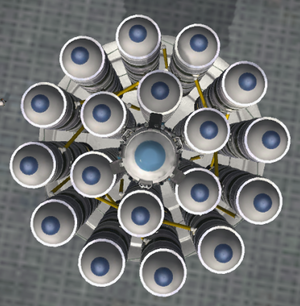Asparagus staging/fr
Le montage en asperge (asparagus staging) est une méthode hautement efficace de conception de fusée. Cette technique est utilisée sur le vaisseau Kerbal X, disponible par défaut.
Ceci est une traduction de la version anglaise par Mixoupe.
Concept
L'idée est de créer une fusée composée de moteurs (et de réservoirs) montés en parallèle. Tous les moteurs s'allument en même temps. Le truc, cependant, c'est que chaque moteur n'est pas seulement connecté à son propre réservoir, mais qu'ils forment une chapine, tous les moteurs consommant en priorité le carburant des réservoirs situés en bout de chaîne. Lorsque ces derniers sont vides, ils sont largués, ainsi que leur moteur, et les réservoirs suivants commencent à se vider. L'intérêt réside principalement dans le fait que lorsqu'un réservoir se vide, les réservoirs en amont dans la chaîne reste complètement pleins alors que tous les moteurs fonctionnent à plein régime depuis le lancement. Le résultat est que la fusée vole avec le nombre minimum de réservoirs nécessaires pour contenir le carburant, à chaque instant, tout en utilisant en permanence la puissance de tous les moteurs disponibles. De ce fait, lorsque vous larguez l'avant dernier, le réservoir central est encore plein à ras bord alors que son moteur fonctionne depuis le lancement.
Pour la conception pratique, on utilisera donc des conduites de carburants (Fuel Duct) pour connecter les étages dans l'ordre où ils seront largués. Ceci garantit que les moteurs utilisent toujours le carburant des réservoirs les plus éloignés.
Le montage en asperge est principalement utilisé au décollage pour mettre en orbite de lourdes charges utiles pour les missions munaires ou plus éloignées. Elle peut aussi être utile pour lancer une station spatiale. Dans tous les cas, ce montage sera moins coûteux en carburant qu'un autre, et nécessitera moins de moteurs/boosters.
Disadvantages
The biggest disadvantage of this technique is the complexity of building it. Usually the symmetry modes can only be used partially. One way is to only mirror each separate stage allowing to use symmetry for the complete setup. One drawback is, that the engines then are not always at the same height which may induce torque. Another way is to build everything except the fuel lines with the symmetry mode, but there each fuel line needs to be placed manually.
With more massive payloads it may require more layers of fuel stacks and struts, making the technique challenging due to the high part count. Although a rocket without asparagus staging has a higher part count because it is more inefficient. The part count can be reduced by installing rocket part mods that provide fuel tanks and engines of larger sizes, allowing to achieve equal performance with less parts, more stability and better looks.
Another disadvantage is that rockets utilizing this design may be unrealistic, because in the real world it is impractical or impossible to move fuel as quickly as would be needed. It also might look not aesthetic especially with multiple layers, because there are then many small rockets bundled together.
The rocket tends to start to roll when using this type of staging which might result in a loss in control of the craft. It also loses thrust with each staging event but only a lower mass compared to other staging methods. This can cause a serious drop of velocity reducing the efficiency.
Drag
As rockets with asparagus staging may be wider than usual vertical stacked their real world drag would be higher. But as the drag depends on the mass instead of the cross-sectional area, there is no disadvantage of using asparagus staging when comparing the drag with other methods.
Although this might change in the future — the developers have already announced that the aerodynamic model will be made more realistic in future versions[citation needed][not cited in the link] — this will most likely not a big issue, as the advantages outweigh this. But it will likely make it a lot more challenging to create aerodynamic crafts which use this technique excessively.
Real world application
This system is currently only a feature of Kerbal Space Program. In the real world there might be one craft, the Falcon Heavy by 2014/2015 which uses this type of staging, although only with one level. The problem with asparagus staging is, that transferring fuel to an engine is already complicated. With additional pumps transferring between tanks the rocket becomes more complicated which may reduce the reliability. Another — very important — important reason are pressure losses that occur because of additional piping and further valves. This can call for added propellant pumps, which negatively impacts the efficiency of asparagus staging.
In 1947, Mikhail Tikhonravov developed this kind of staging which he called “packet rockets”. This led to the development of the R-7 Semyorka. Later developments of this rocket became then the R-7 rocket family. But all those rockets never used the original “packet rockets”/asparagus staging.
Name
The application of the term "asparagus" to a form of rocket staging predates Kerbal Space Program and is not a creation of the players. The "Asparagus-Stalk Booster" was described by aerospace engineer Ed Keith on page 144 of Tom Logsdon's "Orbital Mechanics: Theory and Applications" in 1997.

